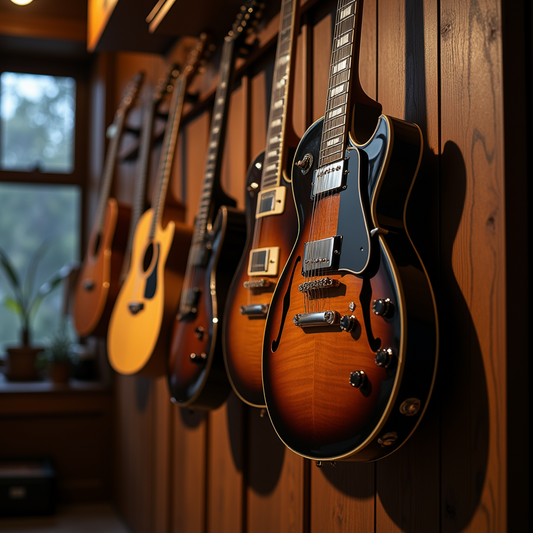How to Choose Your First Guitar and Essential Accessories: A Beginner's Guide
Share
Introduction
Choosing your first guitar is an exciting step in your musical journey, but it can also be overwhelming. With so many types of guitars and accessories available, knowing where to start can be challenging. Whether you're interested in playing folk, rock, or classical music, finding the right guitar and the right accessories is key to setting yourself up for success. In this detailed guide, we’ll break down how to choose your first guitar, what to look for in accessories, and offer expert tips to ensure you're fully prepared to start playing.
1. Choosing the Right Type of Guitar: Acoustic, Electric, or Classical?
Your first guitar should match your musical interests and playing style. Here’s a breakdown of the different types of guitars to help you decide:
Acoustic Guitars
Acoustic guitars are the most straightforward option for beginners because they don’t require an amplifier. They’re perfect for playing folk, country, and pop music. Acoustic guitars have a resonating body that projects sound, and the strings are typically made of steel, giving the instrument a bright, clear tone. One of the most important factors when selecting an acoustic guitar is the tonewood used in its construction—common options include spruce, mahogany, and cedar.
Electric Guitars
Electric guitars are ideal for those interested in rock, metal, blues, or jazz. They offer a wider range of sounds and effects than acoustic guitars, but they require an amplifier. Electric guitars typically have thinner necks and smaller bodies, making them easier to play for some people. They are also generally more versatile when it comes to altering your sound using pedals, amps, and effects. If you’re drawn to the world of electric guitar music, keep in mind that you will need to budget for an amplifier and possibly cables as well.
Classical Guitars
Classical guitars have nylon strings, which are softer and gentler on the fingers compared to steel strings. This makes them a great choice for beginners, particularly those with smaller hands or those who want to focus on fingerpicking. Classical guitars are primarily used for classical, flamenco, and acoustic music, and their wider necks provide more room for finger placement. If you're interested in traditional music or classical guitar techniques, a classical guitar might be the best option for you.
Tip: If you’re still unsure which type to pick, consider your favorite music genre. Choosing a guitar that aligns with your musical tastes will make practicing more enjoyable and help you stay motivated.
2. What Size Guitar Do You Need? Finding the Perfect Fit
One of the most important factors when selecting a guitar is the size. If the guitar feels uncomfortable to play, it can lead to frustration, especially for beginners. Guitars come in various sizes, and choosing the right size ensures that you can comfortably reach all the frets and hold the guitar correctly.
- Full-size guitars: These are ideal for teenagers and adults with average hand sizes. A standard full-size guitar is usually 40-42 inches in length.
- 3/4-size guitars: Best for younger players or individuals with smaller hands. They’re easier to handle while still offering the full guitar experience.
- 1/2-size or 1/4-size guitars: These are perfect for younger children who are just starting out. They provide better playability for small hands and are lightweight.
Tip: When in doubt, try out a few guitars in-store. A guitar should feel natural and comfortable, with your hands easily reaching the frets and the neck. It should also feel balanced when you’re holding it.
3. What to Look for in Your First Guitar: Key Features to Consider
After deciding on the guitar type and size, there are additional features to consider that will affect the sound and playability. Here's a quick checklist:
- Quality of Wood: The type of wood used in the construction of the guitar affects both its sound and longevity. For acoustic guitars, look for solid wood (like spruce or mahogany) for better sound quality. Electric guitars typically feature a combination of solid wood and laminated materials.
- Neck and Fretboard: A smooth neck and fretboard ensure comfortable playability. Be sure to check for any sharp fret ends, which can cause discomfort.
- Action: Action refers to the height of the strings above the fretboard. Lower action makes it easier to press the strings down, which is great for beginners. Higher action may produce a clearer tone but requires more finger pressure.
- Tuners: Quality tuners are crucial for keeping your guitar in tune. Look for a guitar with reliable tuners that will hold the tuning longer and keep your instrument sounding its best.
Tip: Take your time to try different models. The guitar should feel easy to play and should have a tone you enjoy.
4. Essential Guitar Accessories for Beginners
While the guitar itself is the centerpiece of your setup, there are several accessories you’ll need to make your learning experience smoother. Here’s a list of essential items:
1. Guitar Picks
Picks come in various materials, shapes, and thicknesses, each offering a different playing experience. For beginners, a medium thickness pick is a good all-around choice, as it’s versatile for strumming and picking. Experiment with different types of picks to find what works best for you.
2. Guitar Strap
A strap helps you play standing up comfortably. Look for one that’s adjustable and made of durable materials like leather or nylon. A good strap ensures that you can practice for longer periods without discomfort.
3. Tuner
A clip-on tuner is a beginner’s best friend. It helps you tune your guitar easily and accurately, which is essential for developing a good ear. Electronic tuners are widely available and are easy to use with a simple clip that attaches to the headstock of the guitar.
4. Guitar Case or Gig Bag
A padded case or gig bag will protect your guitar from damage during transport. If you plan on taking your guitar to lessons or gigs, a sturdy gig bag is essential. A hard case provides even more protection for long-term storage.
5. Capo
A capo is an important tool for adjusting the pitch of the guitar without changing the tuning. It's useful for playing along with songs in different keys, and it helps beginner players easily switch between chords.
6. Spare Strings
Strings can break, especially with frequent practice. Keep a spare set of strings handy, and learn how to change them. Different guitars require different types of strings, so make sure you get the right ones for your instrument.
7. Guitar Stand
Invest in a guitar stand to keep your instrument safe when not in use. A guitar stand allows you to display your guitar easily, encouraging you to practice more often.
5. Regular Guitar Maintenance: Keep Your Guitar in Top Shape
Proper maintenance will keep your guitar sounding great and extend its lifespan. Here are a few simple maintenance tips:
- Tune Regularly: Always tune your guitar before playing. Regular tuning will not only improve your sound but also train your ear to recognize correct pitch.
- Clean the Guitar: Wipe your guitar down after every use to remove dust, oils, and sweat that can accumulate on the body and strings. Use a soft cloth to avoid scratches.
- Check the Strings: Regularly inspect your strings for wear. If they look dull or feel rough, replace them to ensure optimal sound quality.



